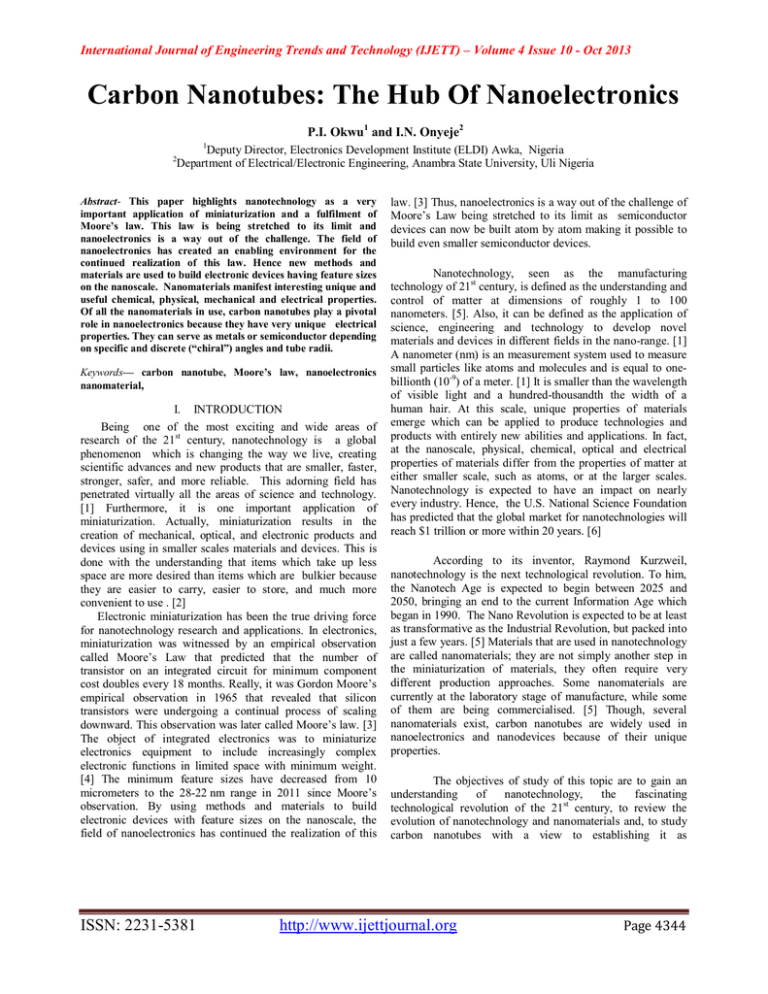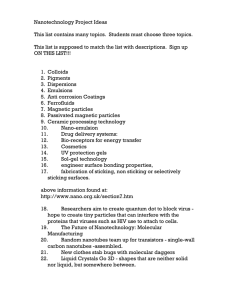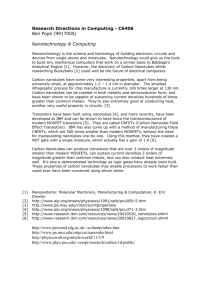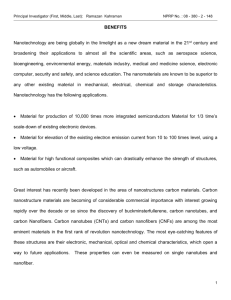Carbon Nanotubes: The Hub Of Nanoelectronics P.I. Okwu
advertisement

International Journal of Engineering Trends and Technology (IJETT) – Volume 4 Issue 10 - Oct 2013 Carbon Nanotubes: The Hub Of Nanoelectronics P.I. Okwu1 and I.N. Onyeje2 1 Deputy Director, Electronics Development Institute (ELDI) Awka, Nigeria Department of Electrical/Electronic Engineering, Anambra State University, Uli Nigeria 2 Abstract- This paper highlights nanotechnology as a very important application of miniaturization and a fulfilment of Moore’s law. This law is being stretched to its limit and nanoelectronics is a way out of the challenge. The field of nanoelectronics has created an enabling environment for the continued realization of this law. Hence new methods and materials are used to build electronic devices having feature sizes on the nanoscale. Nanomaterials manifest interesting unique and useful chemical, physical, mechanical and electrical properties. Of all the nanomaterials in use, carbon nanotubes play a pivotal role in nanoelectronics because they have very unique electrical properties. They can serve as metals or semiconductor depending on specific and discrete (“chiral”) angles and tube radii. Keywords— carbon nanotube, Moore’s law, nanoelectronics nanomaterial, I. INTRODUCTION Being one of the most exciting and wide areas of research of the 21st century, nanotechnology is a global phenomenon which is changing the way we live, creating scientific advances and new products that are smaller, faster, stronger, safer, and more reliable. This adorning field has penetrated virtually all the areas of science and technology. [1] Furthermore, it is one important application of miniaturization. Actually, miniaturization results in the creation of mechanical, optical, and electronic products and devices using in smaller scales materials and devices. This is done with the understanding that items which take up less space are more desired than items which are bulkier because they are easier to carry, easier to store, and much more convenient to use . [2] Electronic miniaturization has been the true driving force for nanotechnology research and applications. In electronics, miniaturization was witnessed by an empirical observation called Moore’s Law that predicted that the number of transistor on an integrated circuit for minimum component cost doubles every 18 months. Really, it was Gordon Moore’s empirical observation in 1965 that revealed that silicon transistors were undergoing a continual process of scaling downward. This observation was later called Moore’s law. [3] The object of integrated electronics was to miniaturize electronics equipment to include increasingly complex electronic functions in limited space with minimum weight. [4] The minimum feature sizes have decreased from 10 micrometers to the 28-22 nm range in 2011 since Moore’s observation. By using methods and materials to build electronic devices with feature sizes on the nanoscale, the field of nanoelectronics has continued the realization of this ISSN: 2231-5381 law. [3] Thus, nanoelectronics is a way out of the challenge of Moore’s Law being stretched to its limit as semiconductor devices can now be built atom by atom making it possible to build even smaller semiconductor devices. Nanotechnology, seen as the manufacturing technology of 21st century, is defined as the understanding and control of matter at dimensions of roughly 1 to 100 nanometers. [5]. Also, it can be defined as the application of science, engineering and technology to develop novel materials and devices in different fields in the nano-range. [1] A nanometer (nm) is an measurement system used to measure small particles like atoms and molecules and is equal to onebillionth (10-9) of a meter. [1] It is smaller than the wavelength of visible light and a hundred-thousandth the width of a human hair. At this scale, unique properties of materials emerge which can be applied to produce technologies and products with entirely new abilities and applications. In fact, at the nanoscale, physical, chemical, optical and electrical properties of materials differ from the properties of matter at either smaller scale, such as atoms, or at the larger scales. Nanotechnology is expected to have an impact on nearly every industry. Hence, the U.S. National Science Foundation has predicted that the global market for nanotechnologies will reach $1 trillion or more within 20 years. [6] According to its inventor, Raymond Kurzweil, nanotechnology is the next technological revolution. To him, the Nanotech Age is expected to begin between 2025 and 2050, bringing an end to the current Information Age which began in 1990. The Nano Revolution is expected to be at least as transformative as the Industrial Revolution, but packed into just a few years. [5] Materials that are used in nanotechnology are called nanomaterials; they are not simply another step in the miniaturization of materials, they often require very different production approaches. Some nanomaterials are currently at the laboratory stage of manufacture, while some of them are being commercialised. [5] Though, several nanomaterials exist, carbon nanotubes are widely used in nanoelectronics and nanodevices because of their unique properties. The objectives of study of this topic are to gain an understanding of nanotechnology, the fascinating technological revolution of the 21st century, to review the evolution of nanotechnology and nanomaterials and, to study carbon nanotubes with a view to establishing it as http://www.ijettjournal.org Page 4344 International Journal of Engineering Trends and Technology (IJETT) – Volume 4 Issue 10 - Oct 2013 nanoelectronics hub. The paper is divided into five chapters. In chapter one, the introduction is presented. Chapter two discusses the evolution of nanotechnology and nanomaterials. Furthermore, in chapter three, carbon nanotubes and nanoelectronics were studied. Chapter four focuses on trends in nanoelectronics while chapter five contains the conclusion. II. THE EVOLUTION OF NANOTECHNOLOGY NANOMATERIALS Today, nanotechnology is among the areas of science and technology that are making exponential progress. Within two centuries, we experienced several technological revolutions in the fields of industry, agriculture, and medicine and information technology. That notwithstanding, we have been able to exploit only a small fraction of the total possibilities since the matter is being dealt with at a bigger scale. Our engineering skills and products are bigger than the nano size and hence have limitations in manipulation. With its capacity to manipulate the smallest possible component of the matter, the nano technology has the potential to bring that cycle of technological revolution to completion by dealing with the matter atom by atom, molecule by molecule. This capacity of mankind to deal with matter at molecular level gives him a new ability to shape process and create things which have never been thought of. [7] A. The Concept of Nanotechnology Nanotechnology is a fundamental technology that allows us to do new things in almost every conceivable technological discipline. [6] Furthermore, it refers to technologies in which matter is manipulated on the atomic and molecular scale to create novel materials and processes. In simple terms, nanotechnology can be defined as ‘engineering at a very small scale whereas in layman's terms, it refers to materials, applications and processes designed to work on extremely tiny scales. This capability also simultaneously gives us the ability to build materials and devices or shapes and products on that scale. Due to the brevity in operation, smarter and lighter products can be made from the molecules of the same matter with every atom in its specified place. The matter displays unimaginably different qualities when manipulated and structured at nano scale. ‘Nano’ means dwarf in Greek. [1] Although nano means small, it is of high potency, and emerging with large applications piercing through all the discipline of knowledge, leading to industrial and technological growth. B. History of Nanotechnology Development Although nanotechnology is a relatively recent development in scientific research, the development of its central concepts happened over a longer period of time. However, it was the convergence of experimental advances such as the invention of the scanning tunnelling in 1981 and ISSN: 2231-5381 the discovery of fullerenes in 1985 that resulted emergence of nanotechnology in the 1980s.[8] in the The scanning tunneling microscope (STM) was developed by Gerd Binnig and Heinrich Rohrer at IBM Zurich Research Laboratory and was an instrument for imaging surfaces at the atomic level. [9] On the other hand, fullerenes were discovered in 1985 by Hany Kroto, Richard Smalley, and Robert Curl. The invention of the scanning tunneling microscope (STM) allowed the first direct manipulation of individual atoms. C. Applications Generally, in nanotechnology, we move from simple to complex and an example of this category is the nano coating which can repel dirt and reduce the need for harmful cleaning agents. In the complex group of the application of nanotechnology is the mobile phone, which has changed dramatically in a few years, becoming smaller and smaller, while at the same time, growing cleverer, faster and even cheaper. [10] Furthermore, nanotechnology is helping to considerably improve and even revolutionize many technological and industrial sectors such as information technology, energy, environmental science, medicine, homeland security, food safety, and transportation, among many others. [11] With nanotechnology, materials can effectively be made to be stronger, lighter, more durable, more reactive, or better electrical conductors, among many other traits. D. Nanomaterials Nanomaterials manifest extremely fascinating and useful properties, which can be exploited for a variety of applications. Usually materials at this small scale behave differently from their macro-scale counterparts thereby opening up a new area of manufacturing where products are designed and built from the bottom-up. [12] Thus, with nanotechnology, a large set of materials and improved products rely on a change in the physical properties when the feature sizes are shrunk. For example, nanoparticles take advantage of their increased surface area to volume ratio. Their optical properties, e.g. fluorescence, become a function of the particle diameter. When brought into a bulk material, nanoparticles can strongly influence the mechanical properties of the material, like stiffness or elasticity. Enhancing materials with nanotechnology will enable a weight reduction accompanied by an increase in stability and improved functionality. E. Nanodevices In order to produce nanodevices, there is the need to understand the fundamental phenomena, the synthesis of http://www.ijettjournal.org Page 4345 International Journal of Engineering Trends and Technology (IJETT) – Volume 4 Issue 10 - Oct 2013 appropriate materials, the use of those materials to fabricate functioning devices and the integration of these devices into working systems. Nanofabrication refers to the building of machines that operate on an atomic or molecular scale. They are smaller, faster and consume less power than conventional electronics and because you can pack so much on to one computer chip, you can have many more functions. Such technology has huge potential in the field of communications, data storage, solar cells and medical applications. . Nanofabrication is of interest to computer engineers because it opens the door to super-high-density microprocessors and memory chips. III.CARBON NANOTUBES and NANOELECTRONICS Carbon nanotubes (CNTs) are allotropes of carbon with a cylindrical nanostructure which have been constructed with length to diameter ratio of up to 132,000.000:1 and have unusual properties which are valuable for nanotechnology, electronics, optics and other fields of material science and technology. In particular, owing to their extraordinary thermal conductivity, mechanical and electrical properties, carbon nanotubes find applications as additives to various structural materials. A carbon nanotube is a tube-shaped material, made of carbon with a continuous unbroken hexagonal mesh and carbon molecules at the apexes of the hexagons. Carbon Nanotubes have many structures, differing in length, thickness, and in the type of helicity and number of layers. Although they are formed from essentially the same graphite sheet, their electrical characteristics differ depending on these variations, acting either as metals or as semiconductors. Nanotubes are members of the fullerene structural family, which also includes the spherical buckyballs and the ends of a nanotube may be capped with a hemisphere of the buckyball structure. Their name is derived from their long, hollow structure with the walls formed by one-atom-thick sheets of carbon, called graphene. These sheets are rolled at specific and discrete (“chiral”) angles, and the combination of the rolling angle and radius decides the na notube properties; for example, whether the individual nanotube shell is a metal or semiconductor. A. Types of Carbon Nanotubes Carbon Nanotubes can be categorized by their structures: Single-wall Nanotubes (SWNT), Multi-wall Nanotubes (MWNT) and Double-wall Nanotubes (DWNT). [13] A single-walled carbon nanotube (SWNT) may be thought of as a single atomic layer thick sheet of graphite (called graphene) rolled into a seamless cylinder. Single-wall carbon nanotubes are hollow cylinders of carbon atoms bound together in a hexagonal pattern and usually about a nanometer in diameter. Most single-walled nanotubes (SWNT) have a diameter of close to 1 nanometer, with a tube length that can be many millions of times longer. Single-walled nanotubes are likely candidates for miniaturizing electronics. SWNTs with diameters of an order of a nanometer can be excellent conductors. The most basic building block of these systems is the electric wire, and one useful application of SWNTs is in the development of the first intermolecular field-effect transistors (FET). [14] B. Electrical Properties of Carbon Nanotubes Nanotubes have exceptional electrical properties. The conductive properties of nanotubes depend on both the diameter and the chirality of the hexagonal carbon lattice along the tube. One fascinating feature of nanotubes is that there are many ways to wrap the hexagon sheet into a cylinder, from perfectly even rows of hexagons that wrap around in a ring, to rows that wrap in spirals at various angles called "chiralities." Thus, a nanotube is a function of its diameter and the chiral angle. A slight change in the winding of the hexagons along the tube can transform the tube from a metal into a large gap semiconductor. Chirality is critical to the electronic properties of carbon nanotubes. Some structures are electrical conductors—essentially a nanoscale wire— others are semiconductors. [15] C. Nanoelectronics The use of nanotechnology on electronic components, especially transistors is referred as nanoelectronics. The aim of the field of nanoelectronics is the continued realization of Moore’s law by using new methods and materials to build electronic devices with feature sizes on the nanoscale. Nanoelectronics often refer to transistor devices that are so small that inter-atomic interactions and quantum mechanics properties need to be studied extensively. [3]Besides being small and allowing more transistors to be packed into a single chip, the uniform and symmetrical structure of nanotube allows higher electron mobility and a higher dielectric constant. [3] D. Applications of Carbon Nanotubes in Nanoelectronics Most of the interest generated by carbon nanotubes has been in applications to electronic materials and some of them are: Fig.1 Carbon Nanotube (Opened and Flattened) ISSN: 2231-5381 http://www.ijettjournal.org Page 4346 International Journal of Engineering Trends and Technology (IJETT) – Volume 4 Issue 10 - Oct 2013 1) Better Solar Cells: Usually solar cells use silicon semiconductors. However when carbon nanotubes are incorporated into the semiconductor, a change occurs. Now billions of CNTs could be tightly packed onto solar cells and release far more electricity per square inch than silicon because they're so tiny. 2) Better, Thinner TVs: An array of CNTs is used in field emission as they are excellent electron emitters. There is now new process of displaying pictures called field emission display. This miniaturizes the process by using tiny electron emitters positioned behind individual phosphorus dots displays to excite the phosphorus dots, creating bright, high resolution displays. With the help of CNTs we can produce TVs that are only millimetres thick and consume less power than plasma and liquid crystal displays. 3) Better Capacitors that Replace Batteries: The capacitance of a capacitor is a function of the surface area. CNTs have extraordinarily high surface areas, and using them as the dielectrics could increase the storage ability of capacitors to be on par with modern batteries. 4) Electrical Wires and Cables: Electric wires and cables can now be fabricated from pure nanotubes and nanotube-polymer composites. It is interesting to note that in recent times that wires have been fabricated using the highest conductivity carbon nanotube with specific conductivity exceeding copper and aluminium. 5) Paper Batteries: Batteries are essential in electronic components and now there are paper batteries. A paper battery is a type that is designed to use a paper-thin sheet of cellulose infused with aligned carbon nanotubes. The nanotubes act as electrodes and thus allow the storage devices to conduct electricity. This type of battery can provide a long, steady power output comparable to a conventional battery. The paper battery integrates all of the battery components in a single structure, making it more energy efficient. 6) Faster Computers: Carbon nanotubes can now be incorporated into chips in order to improve its speed. With CNTs in computer chips many billions of CNT transistors could be packed onto a single processing chip, making for smaller, faster computers and electronics. IV. TRENDS IN NANOELECTRONICS Being a revolutionary, transformative and powerful technology, nanotechnology is seen as the latest mega trend in science and engineering which will bring a wave of radical innovation, thereby sparking new industrial revolution in various application areas. For nanoelectronic applications, carbon nanotubes are attractive due to their excellent electric properties. An important area of research is molecular electronics, for which molecules that are quantum electronic ISSN: 2231-5381 devices are designed and synthesized with the ultimate goal of using individual molecules as switches and carbon nanotubes as the wires in circuits which are expected to result in nonvolatile memories. Another trend is in the application of nanowires in electronic, opto-electronic and nanoelectromechanical devices. There is also nanomotor which is a molecular device capable of converting energy into movement and nanoelectromechanical systems (NEMS). NEMS typically integrate transistor-like nanoelectronics with mechanical actuators, pumps, or motors, and may thereby form physical, biological, and chemical sensors. Metallic carbon nanotubes have also been proposed for nanoelectronic interconnects since they can carry high current densities. Carbon nanotubes have found so much use in NEMS that methods have already been discovered to connect suspended carbon nanotubes to other nanostructures. This allows carbon nanotubes to be structurally set up to make complicated nanoelectric systems .Also, since some carbon nanotubes are semiconducting, they can be used in transistors. By exchanging the silicon in the channel for a carbon nanotube, the transistors can be made both smaller and faster than today's transistors. There is now an emerging trend of picotechnology involving the alteration of the structure and chemical properties of individual atoms, typically through the manipulation of energy states of electrons within an atom to produce metastable states with unusual properties, producing some form of exotic atom. The term picotechnology is a neologism intended to parallel the term nanotechnology. It is a hypothetical future level of technological manipulation of matter, on the scale of trillionths of a meter. Furthermore, there is femtotechnology which is also a hypothetical term used in reference to structuring of matter which is 10−15 m. This is a smaller scale in comparison to nanotechnology and picotechnology. V. CONCLUSION The future for carbon nanotubes looks bright due to the fact that they are extremely versatile. There appears to be no other material that is as strong, conducting, inert, and so forth at the same time. The rapid progress with nanotubes is largely driven by its unique combination of properties. A very important property of carbon nanotube is very high surface area which increases the amount of charge that can be stored. Carbon nanotubes are another possible material for use in an ultracapacitor. Ultracapacitors have high density interior, compact size, reliability, and high capacitance. This decrease in size makes them increasingly possible to develop much smaller circuits and computers. REFERENCES [1] Mathan42 (2012) . Nanotechnology - Applications, Uses and Future [Online] Available: http://mathan42.hubpages.com/hub/worldofnanotech nology http://www.ijettjournal.org Page 4347 International Journal of Engineering Trends and Technology (IJETT) – Volume 4 Issue 10 - Oct 2013 [2] Wikipedia (2012) Miniaturization [Online]. Available: :http://en.wikipedia.org/wiki/Miniaturization [3] Wikipedia (2012) Nanoelectronics [Online] Availale: http://en.wikipedia.org/wiki/Nanoelectronics [4] G.E Moore, “Cramming more components onto integrated circuits”, Electronics, vol., 38, no.8, 114117, April 1965, [5] (2012) The Nanotechnology Age [Online], Available: http://thenanoage.com/ [6] C. Ganesh (2012) Nanotechnology, Its Importance & Applications, [Online] Available: http://www.indianmba.com/Faculty_Column/FC748/ fc748.html [7] (2012) Nanotechnology and Nanoscience Applications: Revolution in India and beyond [Online] Available: http://www.sainsce.com/PDF/Nanoscience_&_Nanot echnology_in_India_&_world.pdf [8] Wikipedia (2012) Nanotechnology beyond [Online] Available: http://en.wikipedia.org/wiki/Nanotechnology [9] Wikipedia (2012) Scanning Tunnelling Microscope beyond[Online]Available: http://en.wikipedia.org/wiki/Scanning_tunneling_mic roscope [10] K.E. Drexler (2013), “What is Nanotechnology? “[Online] ,Available: http://www.nano.org.uk/whatis-nanotechnology [11] (2012) “Benefits and Applications of Nanotechnology” [Online] Available: http://www.nano.gov/you/nanotechnology-benefits [12] (2012) “Products Using Nanotechnology”, [Online] Available: http://www.ehow.com/about_4793256_prod ucts-using-nanotechnology.html [13] (2012) “Carbon Nanotube.” [Online], Available: [14] [15] http://en.wikipedia.org/wiki/Carbon_nanotube (2013) “Cloning' Could Make Structurally Pure Nanotubes for Nanoelectronics” [Online] Available: http://www.nist.gov/mml/msed/nanotubes111412.cfm, (2013) “Carbon Nanotube Electronics”, [Online] Available: http://www.physics.umd.edu/mfuhrer/ntresearch.htm ISSN: 2231-5381 http://www.ijettjournal.org Page 4348





